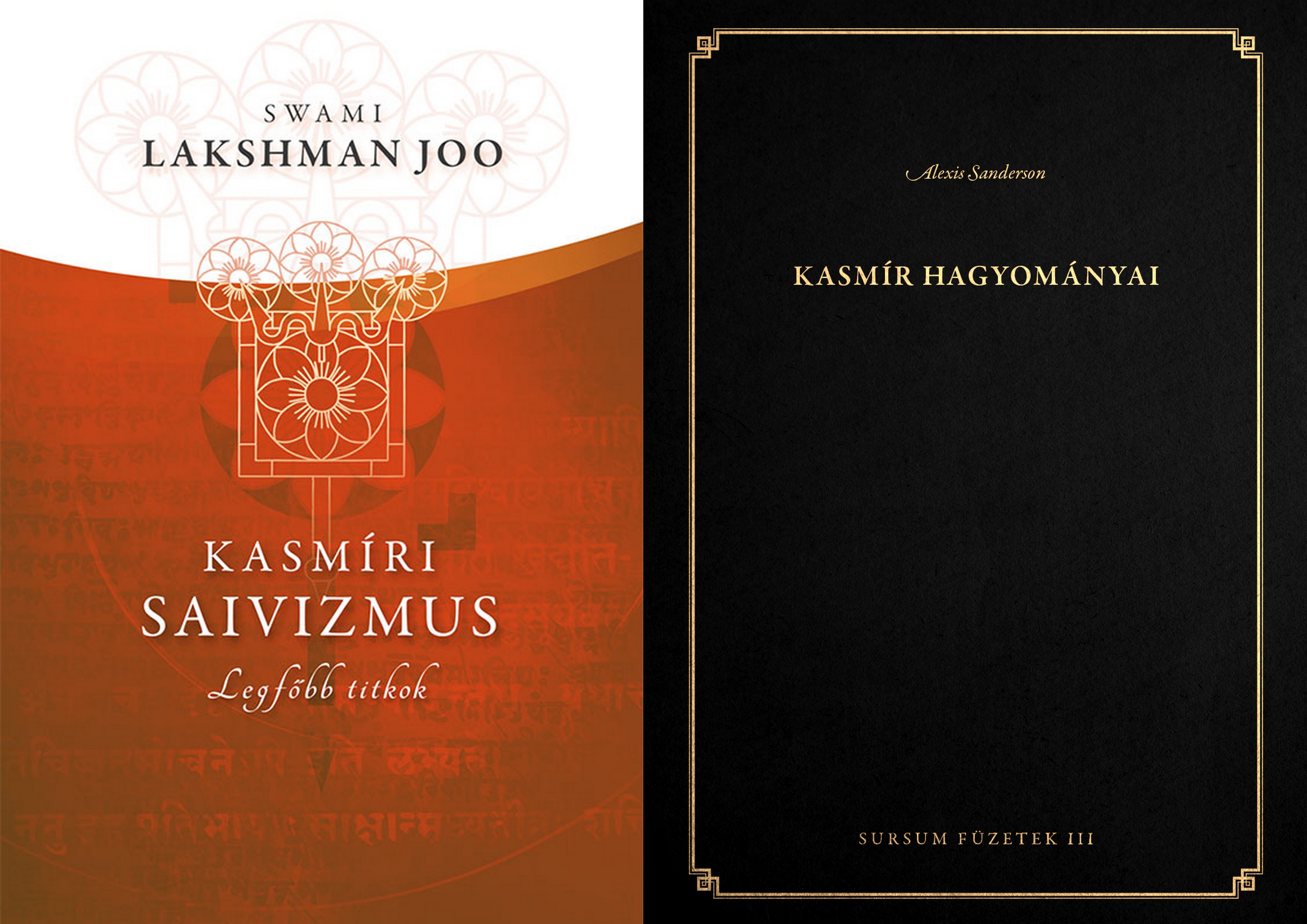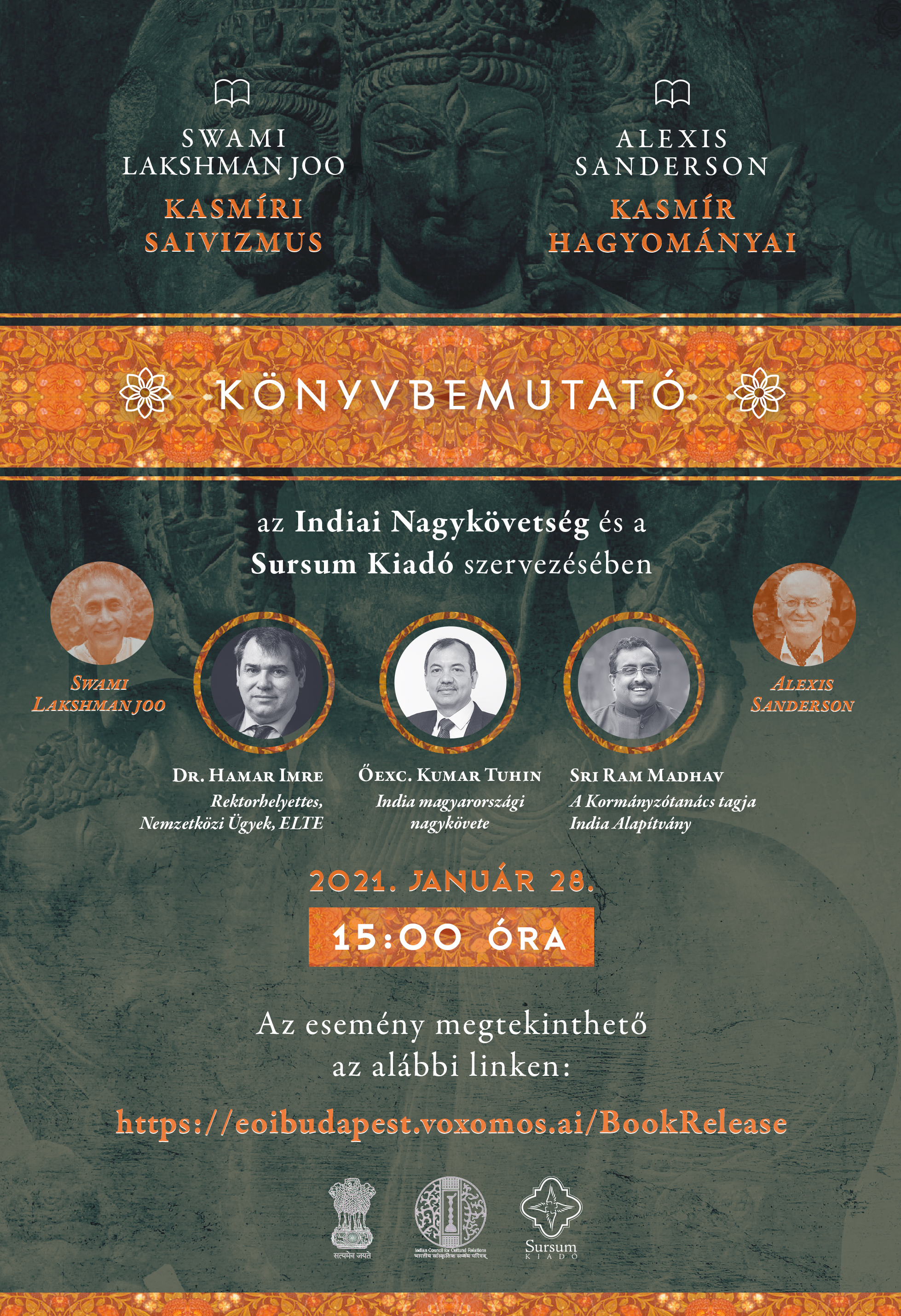Könyvbemutató / Book Release
Posted on: January 18, 2021 | Back | Print
Könyvbemutató / Book Release
Swami Lakshman Joo: Kasmiri saivizmus
Alexis Sanderson: Kasmír hagyományai
*
2021. január 28-án a Sursum Kiadóval együttműködve online könyvbemutatóra invitáljuk Önöket.
Időpont: 2021. január 28, 15.00 (magyar idő szerint)
A beszélgetés nyelve magyar, angol fordítással.
---
Program:
I. Rész
15.00-15.03 Siva mantra: Dr Chirayu Bhole & zenész kollégái
15.03-15.10 Őexc. Kumar Tuhin, India magyarországi nagykövetének köszöntő beszéde
15.10-15.25 Meghívott vendégeink beszédei
15.25-15.30 Tanuja Shankar, az Amrita Sher-Gil Kulturális Központ igazgatójának rövid videója
*
II. Rész
15.30-15.40 Bevezetés
Dr Dezső Csaba, indológus, ELTE BTK Indológia Tanszék
Kasmír és a saiva hagyományok általános bemutatása (történelem, kultúra, eszmetörténeti jelentőség)
15.40-16.10 Beszélgetés a könyvekről: a kiadó és a fordítók
Horváth Róbert, szerkesztő
Répási Zsolt, fordító
Laki Zoltán, fordító
A kasmíri saivizmus és nyugati párhuzamai, a szerzők (Swami Lakshman Joo és Alexis Sanderson) rövid bemutatása, ízelítő a könyvek tartalmából.
16.10-16.20 Kérdések és válaszok
A programhoz a következő linken keresztül lehet majd csatlakozni:
https://eoibudapest.voxomos.ai/BookRelease,
illetve online lehet követni facebook és youtube oldalunkon.
Minden érdeklődőt szeretettel várunk!
*
A könyvekről:
SWAMI LAKSHMAN JOO: KASMÍRI SAIVIZMUS
Legfőbb titkok
E könyv szentként tisztelt és tudós szerzője arra a monumentális feladatra vállalkozott, hogy feltárja a kasmíri saivizmus monisztikus, egységelvű hagyományvonulatát. Előadásaiban útmutatást ad a śaiva tanítások labirintusában való eligazodáshoz, és mindvégig hangsúlyozza az elméleti igazságok gyakorlati megvalósításának fontosságát. A tizenkilenc fejezet mindegyike egy-egy alapvető tanítást mutat be, a szisztematikus, felsorolásszerű kifejtést pedig az elmondottak mélyebb értelmét megvilágító praktikus példák egészítik ki.
A Kasmíri saivizmus. Legfőbb titkokban Swami Lakshman Joo (1907–1991) lényegre törően foglalja össze Abhinavagupta Tantrāloka című művének azon témaköreit, melyeket a legfontosabbnak tekintett. A harminchat tattvával, a szanszkrit abc ötven betűjével, a tudatosság hét állapotával, a kasmíri saivizmus és a vedānta különbségével, vagy a kuṇḍalinī egyedülálló jelentőségével foglalkozó fejezeteken keresztül átfogó képet ad a nem-dualisztikus kasmíri śaiva bölcseletről – magyar nyelven első ízben.
ALEXIS SANDERSON: KASMÍR HAGYOMÁNYAI
Két tanulmány
Korunk egyik legismertebb indológusának két tanulmánya a kasmíri saivizmus bölcseleti hátterébe és történeti kibontakozásába nyújt betekintést. Az első írás ( „Tisztaság és erő a kasmíri brāhmaṇák körében”) a 9-13. századi Kasmírban jelen lévő vallási irányzatok emberképét tárja fel. A filozófiai szemléletek és társadalmi előírások mélyére hatolva bemutatja, hogyan alakultak ki az emberi személyiség vagy „önvaló” eltérő felfogásai, és milyen szerepet játszott ebben az ortodoxia és heterodoxia, a tisztaság és az erő útjának ellentéte, illetve kölcsönös egymásra hatása.
A második értekezés („Swami Lakshman Joo és helye a kasmíri śaiva hagyományban”) a kasmíri saivizmus új- és legújabbkori történetét tekinti át. Autentikus szövegforrásokra (köztük sok máig kiadatlan kéziratra) támaszkodva felvázolja, milyen formában élt tovább e hagyomány a 13. századot követően, és hogyan jutott el végül az irányzat nagy huszadik századi mesteréhez, Swami Lakshman Joohoz.
***
On 28 January, 2021, we heartily invite you to attend an online book release event organized by the Embassy of India in contibution with Sursum Kiadó.
Date & time: 28 January, 2021, 15.00 (Hungarian time)
Discussion is in Hungarian, with English translation.
Programme:
I. Part
15.00-15.03 Shiva mantra by Dr Chirayu Bhole & musicians
15.03-15.10 Opening address by H.E. Kumar Tuhin, Ambassador of India
15.10-15.25 Keynote address by chief guests
15.25-15.30 Trailer video by Tanuja Shankar
*
II. Part
15.30-15.40 Introduction
Dr Csaba Dezső, Indologist, ELTE BTK Indology Dept., connected online
General presentation of Kashmir and Shaiva traditions (history, culture, historical significance)
15.40-16.10 Discussion by translators / publisher of the books
Róbert Horváth, editor
Zsolt Répási, translator
Zoltán Laki, translator
Kashmiri Shaivism and its paralells in Europe; brief introduction of the authors (Swami Lakshman Joo and Alexis Sanderson), a taste of the content of the books
16.10-16.20 QA session
Please join at the following link:
https://eoibudapest.voxomos.ai/BookRelease
or follow us on our FB & Youtube page.
*
About the books:
SWAMI LAKSHMAN JOO: KASMÍRI SAIVIZMUS
Legfőbb titkok
This book, Kasmíri saivizmus. Legfőbb titkok (Kashmir Shaivism: The Secret Supreme), by the 20th century’s great philosopher saint Swami Lakshman Joo, presents a systematic unfolding of the Tantric teachings of the ancient tradition of Kashmir Shaivism. This profound tradition, long enshrouded in secrecy, is so rich and detailed in its descriptions of what it reveals as the ascent of individual consciousness to universal God consciousness that it has been characterized as a mystical geography of awareness. Within the pages of this book is found the key of the oral tradition which unlocks its secrets and provides the reader with the tools necessary to venture into this wondrous landscape.
In Kashmir Shaivism. The Secret Supreme Swami Lakshman Joo gives the essence of what he considered to be the most important chapters of Abhinavagupta’s Tantrāloka. With chapters on the 36 tattvas, the 50 letters of the Sanskrit alphabet, the seven states of consciousness, the difference between Shaivism and Vedānta, and the uniqueness of kuṇḍalinī in Kashmir Shaivism, Swami Lakshman Joo gives the reader a complete overview of Kashmir Shaiva philosophy – for the first time in Hungarian language.
ALEXIS SANDERSON: KASMÍR HAGYOMÁNYAI
Két tanulmány
Alexis Sanderson is one of the most renowned and appreciated Indologists of our time. The book Kasmír hagyományai contains the Hungarian translation of two of his treatises, which give a comprehensive insight into the philosophical background and historical development of Kashmir Shaivism. The first study, Purity and power among the Brahmans of Kashmir, deals with the self-representation of the Kashmirian community and of the prevalent religious and philosophical currents of Kashmir in the 9th-13th century. Going beneath the surface of philosophical and theological abstractions, he outlines the process through which the different conceptions of human personality and the Self as conscious entity took shape, in the confrontation and mutual interaction of orthodoxy and heterodoxy, the path of purity and the path of power.
The second treatise, Swami Lakshman Joo and His Place in the Kashmirian Śaiva Tradition, reviews the history of Kashmir Shaivism from the 13th to the 20th century. Relying on authentic source texts (among them many unpublished drafts), Alexis Sanderson examines the way in which the Shaiva traditions of Kashmir continued to exist after the 13th century and were finally inherited by Swami Lakshman Joo in the first half of the 20th century.


















